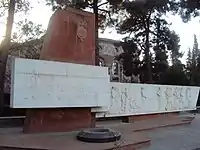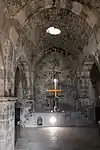Chartar
Chartar (Armenian: Ճարտար; Azerbaijani: Çartar) is a town in the Khojavend District of Azerbaijan, in the disputed region of Nagorno-Karabakh. The town has an ethnic Armenian-majority population, and also had an Armenian majority in 1989.[2]
Chartar
Ճարտար | |
|---|---|
| Çartar | |
 | |
 Chartar | |
| Coordinates: 39°45′29″N 47°00′58″E | |
| Country | |
| • District | Khojavend |
| Population (2015)[1] | |
| • Total | 4,100 |
| Time zone | UTC+4 (AMT) |
History

The area of Chartar is one of ancient Armenian settlement, being home to various monasteries, churches, and khachkars from the 12th-19th centuries.[3] Traditionally, it was part of the diocese of the Amaras Monastery. The modern town was populated by Armenians mostly from Agulis, Maghavuz, and Khachen. The town of Chartar was created out of a merger of the four villages of Ghuze Chartar, Ghuze Kaler, Gyune Chartar and Gyune Kaler.[4][3]
During the Soviet period, the town was a part of the Martuni District of the Nagorno-Karabakh Autonomous Oblast.[3]
Historical and cultural heritage
Historical heritage sites in and around Chartar include Chartar Fortress (from between the 3rd and 1st centuries BCE), the Kohak Church (from between the 10th and 13th centuries), the St. Yeghishe Church from 1655, the church of Surb Amenaprkich (Armenian: Սուրբ Ամենափրկիչ, lit. 'Holy Savior') founded in 1787, and the 19th-century St. George's Church (Armenian: Սուրբ Գևորգ եկեղեցի, romanized: Surb Gevorg Yekeghetsi).[4][5] The St. Vardanank Church (Armenian: Սուրբ Վարդանանք եկեղեցի, romanized: Surb Vardanank Yekeghetsi) was consecrated in 2018 in Chartar.[6]
Economy and culture
The population is mainly engaged in agriculture and animal husbandry. As of 2015, the village has a municipal building, a house of culture, five schools, an art school, two kindergartens, nine shops, a hospital, and a medical centre.[5]
Demographics
According to the Caucasian calendar for 1910, the population of the village by 1908 was 2,757 people, mostly Armenians.[7] By the beginning of 1914, 2,350 inhabitants were recorded, also predominantly Armenians.[8]
Chartar had 3,951 inhabitants in 2005 (with the census divided between "Chartar" with 2,213 inhabitants and "Ghuze Chartar" with 1,738 inhabitants),[9] and 4,100 inhabitants in 2015.[1]
Gallery
 Chartar House of Culture (also called the "Sports and Cultural Palace" of Chartar)
Chartar House of Culture (also called the "Sports and Cultural Palace" of Chartar) WWII monument
WWII monument 13th-century khachkar near the St. Yeghishe Church
13th-century khachkar near the St. Yeghishe Church Tombstone near the St. Yeghishe Church
Tombstone near the St. Yeghishe Church A view of the town
A view of the town Monument to the fallen in the First Nagorno-Karabakh War
Monument to the fallen in the First Nagorno-Karabakh War Chartar Fortress
Chartar Fortress St. Yeghishe Church interior
St. Yeghishe Church interior
Notable people
- Nelson Davidyan, Olympic silver medalist and two-time world champion in Greco-Roman wrestling
References
- "Figures" (PDF). stat-nkr.am. 2015.
- Андрей Зубов. "Андрей Зубов. Карабах: Мир и Война". drugoivzgliad.com.
- Hakobyan, Tadevos Kh.; Melik-Bakhshyan, Stepan T.; Barseghyan, Hovhannes Kh. (1991). "Ճարտար [Čartar]". Հայաստանի և հարակից շրջանների տեղանունների բառարան [Dictionary of Toponyms of Armenia and Adjacent Territories] (in Armenian). Vol. 3. Yerevan State University Press. p. 606. OCLC 247335945.
- Kiesling, Brady; Kojian, Raffi (2019). Rediscovering Armenia: An in-depth inventory of villages and monuments in Armenia and Artsakh (3rd ed.). Armeniapedia Publishing.
- Hakob Ghahramanyan. "Directory of socio-economic characteristics of NKR administrative-territorial units (2015)".
- "Ճարտար քաղաքում տեղի է ունեցել Սրբ Վարդանանք եկեղեցու օծման հանդիսավոր արարողությունը". Artsakh Press. 2018-06-16.
- "Кавказский календарь на 1910 год" [Caucasian calendar for 1910] (in Russian) (65 ed.). Tiflis: Tipografiya kantselyarii Ye.I.V. na Kavkaze, kazenny dom. 1910: 233.
{{cite journal}}: Cite journal requires|journal=(help) - "Кавказский календарь на 1915 год" [Caucasian calendar for 1915] (in Russian). Tiflis: Tipografiya kantselyarii Ye.I.V. na Kavkaze, kazenny dom. 1915: 114.
{{cite journal}}: Cite journal requires|journal=(help) - "The Results of the 2005 Census of the Nagorno-Karabakh Republic" (PDF). National Statistic Service of the Republic of Artsakh.

